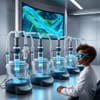The production of cell and gene therapies is a complex and challenging process. Several factors contribute to these challenges, including a shortage of high-quality, GMP-grade raw materials and single-use parts, complex supply chain logistics, and the need for a skilled workforce with unique and specific requirements.
Automation is being increasingly adopted in the field of cell and gene therapy production to address these challenges. By automating various aspects of the production process, manufacturers can increase efficiency, reduce costs, and improve product quality. Automation can also help to minimize the risk of human error and variability, which can have a significant impact on the quality and consistency of the final product.
Closed systems, such as bioreactors and fill-and-finish systems, are also playing a critical role in cell and gene therapy production. These systems provide a controlled environment for cell processing, reducing the risk of contamination and improving product quality. The integration of artificial intelligence (AI) and machine learning into these systems can further enhance their performance, enabling real-time monitoring and optimization of the production process.
The use of AI and machine learning in cell and gene therapy production can also enable predictive maintenance, identifying potential issues before they occur and reducing downtime. This can help to improve overall efficiency and reduce costs.
Several companies are developing innovative automation solutions for cell and gene therapy production. For example, Terumo BCT's Finia Fill and Finish System is a closed-system solution for final cell preparation and cryopreservation. Thermo Fisher Scientific's Automated Cell Therapy Manufacturing Solutions provide integrated systems for cell therapy manufacturing, including bioreactors and fill-and-finish systems.
The adoption of automation, AI, and closed systems in cell and gene therapy production is expected to continue to grow in the coming years. As the demand for these therapies increases, manufacturers will need to adopt new technologies and strategies to improve efficiency, reduce costs, and ensure product quality.


